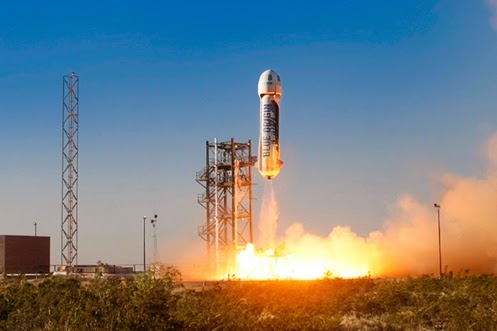© Blue Origin Blue Origin carried out the first developmental test flight of its new Shepard vertical takeoff, vertical landing (VTVL)sp...
 |
| © Blue Origin |
The 110,000-lbf thrust liquid hydrogen, liquid oxygen BE-3 engine worked flawlessly, powering the Shepard through Mach 3 to its planned test altitude of 307,000 feet.
Guidance, navigation and control was nominal throughout max Q and all of ascent.
The system consists of a pressurized capsule atop a booster. The combined vehicles launch vertically, accelerating for approximately two and a half minutes, before the engine cuts off. The capsule then separates from the booster to coast quietly into space. After a few minutes of free fall, the booster performs an autonomously controlled rocket-powered vertical landing, while the capsule lands softly under parachutes, both ready to be used again.
The in-space separation of the crew capsule from the propulsion module was perfect, but due to loss of pressure in a hydraulic system during descent, recovery of the propulsion module failed.
Blue Origin said, it is working on an improved hydraulic system and assembly of propulsion module serial numbers 2 and 3 is already underway to carryout further tests shortly.
 |
| Shepard crew capsule descends to a gentle landing in the west Texas desert © Blue Origin |
In addition to powering the Shepard to space the BE-3 liquid rocket engine is also designed to restart as the vehicle returns, slowing the booster to just 5 mph for landing.
The BE‑3 can be continuously throttled between 110,000-lbf and 20,000-lbf thrust, a key capability for VTTL vehicles.
Fins near the base of the booster pivot to stabilize the vehicle during ascent and steer it back to the landing pad on descent. Hydraulic actuators provide enough force to drive these fins through air speeds up to Mach 4.
The Shepard capsule’s 530 cubic feet interior can seat six astronauts and is large enough to float freely and turn weightless somersaults.
The Shepard's escape system is built around a solid rocket motor that provides 70,000 lb. of thrust in a two-second burn, so the capsule can quickly move away from any hazard.
Blue Origin, LLC, is a privately-funded aerospace company owned by Amazon.com founder Jeff Bezos. The company aims to develop vehicles and technologies to enable commercial human space transportation.
Blue Origin is employing an incremental approach from suborbital to orbital flight, with each developmental step building on its prior work.
The BE‑3 is the third generation of Blue Origin-developed engines. The fourth-generation BE‑4 uses liquid oxygen and liquefied natural gas (LNG) to produce 550,000-lbf thrust at sea level.
Under development since 2012, the BE‑4 provides the lowest cost. It was selected by United Launch Alliance to serve as the primary propulsion for its Next Generation Launch System.
The company is also developing an more capable orbital launch vehicle that is many times the Shepard’s size, powered by the BE-4 engine.










